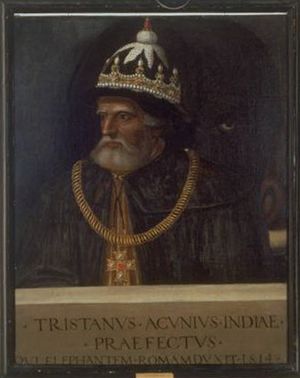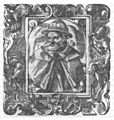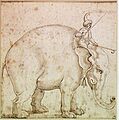Tristão da Cunha facts for kids
Quick facts for kids
Tristão da Cunha
|
|
|---|---|
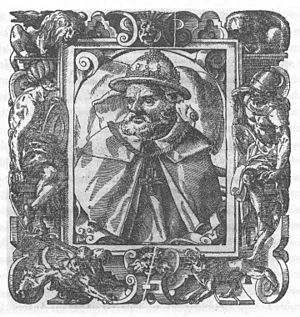
Tristão da Cunha, in a 1575 engraving.
|
|
| Born | c. 1460 |
| Died | c. 1540 (aged 79–80) Kingdom of Portugal
|
| Nationality | Portuguese |
| Occupation | Naval commander, explorer and ambassador |
Tristão da Cunha (born around 1460, died around 1540) was a famous Portuguese explorer. He was also a naval commander, leading ships for Portugal.
In 1514, he became an ambassador for King Manuel I of Portugal. He traveled to Rome to meet Pope Leo X. He led a grand group, showing off Portugal's new lands. Later, he joined the King's special council.
Contents
Tristão da Cunha's 1506 Expedition
Tristão da Cunha was born in Portugal around 1460. In 1504, he was chosen to be the first leader of Portuguese India. However, he could not take the job because he was temporarily blind.
In 1506, he was put in charge of a fleet of 15 ships. These ships were sent to the east coast of Africa and then to India. His cousin, Afonso de Albuquerque, led five ships within this fleet. Their main goal was to take over Socotra Island. They also planned to build a fort there. This would help them control trade in the Red Sea.
They sailed together until they reached Mozambique. In the Mozambique Channel, they found their friend Captain João da Nova. He was stuck there while returning from India. They rescued him and his ship, the Frol de la mar. Both joined the fleet. After successfully attacking Arab cities in Africa, they sailed to Socotra.
Discovering New Islands
During this journey, Tristão da Cunha found a group of islands. These islands are far away in the South Atlantic Ocean. They are about 2,816 kilometers (1,750 miles) from South Africa. The rough seas made it impossible to land there. But he named the main island after himself. It was called Ilha de Tristão da Cunha. Later, this name became Tristan da Cunha in English.
Battle in Barawa
Next, Tristão da Cunha focused on the Ajuran Empire. Here, the Battle of Barawa took place. After a long fight, the Portuguese soldiers burned and looted the city. However, the local people fought back very strongly. The Portuguese could not keep the city. The people who had fled later returned and rebuilt Barawa. Tristão da Cunha was hurt in this battle. After that, he sailed to Socotra.
Mogadishu Campaign
After the battle in Barawa, Tristão decided to gather his men in Socotra. Then, they sailed towards Mogadishu. But news of the Barawa battle had spread. A large number of soldiers had gathered to defend Mogadishu. Many horsemen, soldiers, and warships were ready to protect the city.
Even so, Tristão wanted to attack and try to conquer the city. But every officer and soldier in his army disagreed. They feared they would surely lose if they fought.
Actions in India
After a while, Tristão da Cunha showed his bravery in India. He helped in several important actions. One was the Siege of Cannanore in 1507. The Portuguese soldiers there were almost defeated. But on August 27, Tristão da Cunha's fleet arrived. His 11 ships came from Socotra. He brought 300 men and saved the soldiers.
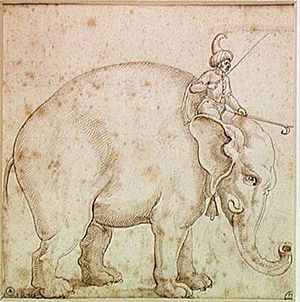
Ambassador to the Pope
After returning to Europe, Tristão da Cunha became an ambassador. King Manuel I sent him to Pope Leo X in 1514. His job was to show the Pope the new lands Portugal had conquered. Garcia de Resende was his secretary.
This huge and fancy group had 140 people. They traveled through Alicante and Majorca. They arrived near Rome in February. On March 12, 1514, they walked through the streets of Rome. It was an amazing parade of exotic animals and riches from India. Many people wore "Indian style" clothes.
The parade included an elephant named Hanno. This elephant was a gift for the Pope. There were also 42 other animals. These included two leopards, a panther, some parrots, turkeys, and rare Indian horses. Hanno carried a silver platform on its back. It looked like a castle. Inside was a safe with royal gifts. These gifts included vests covered in pearls and gems. There were also gold coins made just for this event.
The Pope welcomed the parade at the Castel Sant'Angelo. The elephant knelt three times to show respect. Then, its Indian mahout (keeper) waved. Hanno used its trunk to suck water from a bucket. It sprayed the water over the crowd and the Cardinals.
By April 29, 1514, the Portuguese had spent all their money. But they got a special paper, called a papal bull, signed by the Pope. The Pope also sent rich gifts back to King Manuel. The King replied with a ship full of spices. Later, he sent an indian rhinoceros to the Pope. This rhinoceros was a gift from Sultan Muzaffar Shah II of Gujarat. The ship carrying it sank near Genoa in early 1516. The famous artist Albrecht Dürer drew this rhinoceros in his woodcuts in 1515.
Tristão da Cunha never became the leader of Portuguese India. However, his son Nuno da Cunha became the 9th Governor of Portuguese India in 1529. Tristão da Cunha's tomb is in a convent. It is called Nossa Senhora da Encarnação in Olhalvo, Portugal.
Images for kids
See also
 In Spanish: Tristão da Cunha para niños
In Spanish: Tristão da Cunha para niños


